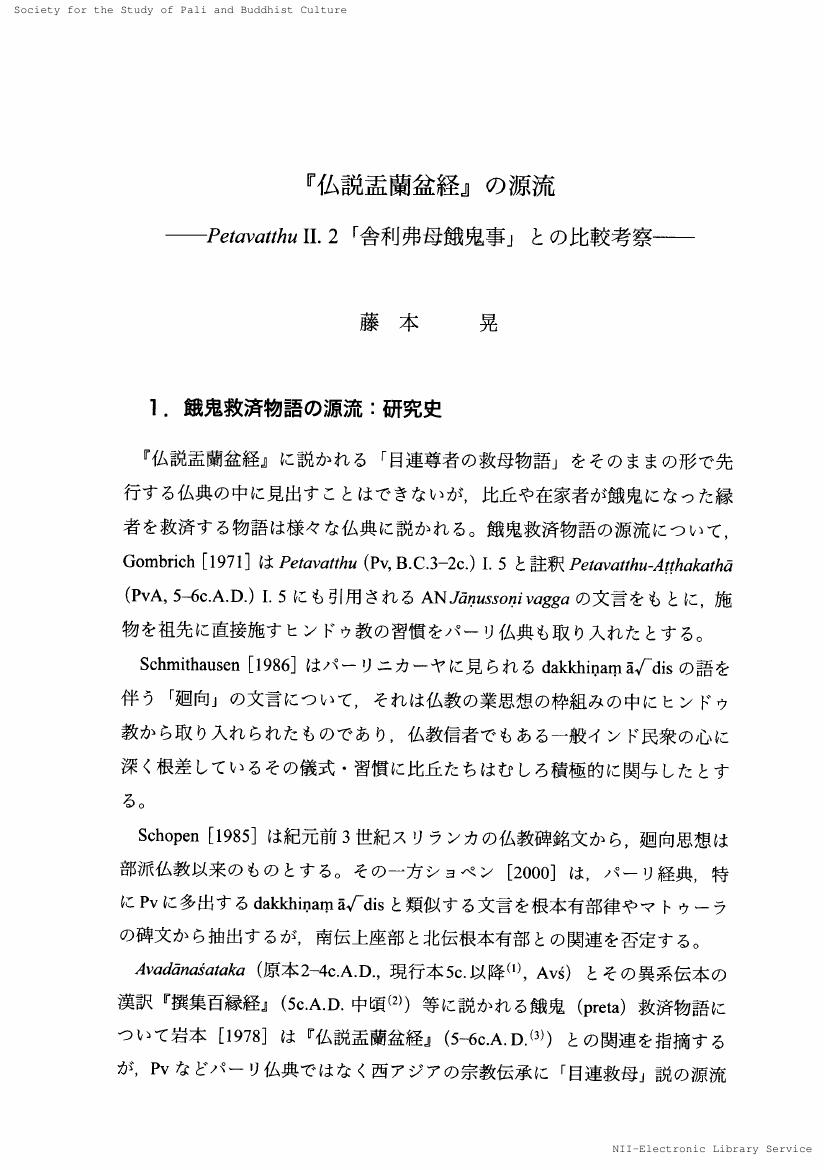38 0 0 0 OA 『仏説孟蘭盆経』の源流 : Petavatthu II.2「舎利弗母餓鬼事」との比較考察
- 著者
- 藤本 晃
- 出版者
- パーリ学仏教文化学会
- 雑誌
- パーリ学仏教文化学 (ISSN:09148604)
- 巻号頁・発行日
- vol.17, pp.47-54, 2003-12-20 (Released:2018-09-01)
4 0 0 0 預流果への道 : 随法行と随信行
- 著者
- 藤本 晃
- 出版者
- パーリ学仏教文化学会
- 雑誌
- パーリ学仏教文化学 (ISSN:09148604)
- 巻号頁・発行日
- no.19, pp.53-63, 2005-12-20
- 著者
- 藤本 晃
- 出版者
- パーリ学仏教文化学会
- 雑誌
- パーリ学仏教文化学 (ISSN:09148604)
- 巻号頁・発行日
- no.17, pp.47-54, 2003-12-20
2 0 0 0 OA 慢性疼痛の神経炎症を中心とした生物学的基盤
- 著者
- 藤本 晃嗣 細井 昌子
- 出版者
- 一般社団法人 日本心身医学会
- 雑誌
- 心身医学 (ISSN:03850307)
- 巻号頁・発行日
- vol.62, no.1, pp.50-56, 2022 (Released:2022-01-01)
- 参考文献数
- 26
器質的疾患を指摘できない慢性疼痛において,近年その生物学的基盤が明らかになりつつある.特に注目を浴びているのが,神経炎症である.視神経脊髄炎スペクトラム障害などの脱髄疾患を中心として神経炎症との関連が明らかになるにつれ,病態に基づいた治療が実臨床に導入されつつある.慢性疼痛においても炎症メディエーターやミクログリアの関与が知られているが,近年グリア細胞の活性をin vivoで評価できる18kDa-translocator protein(TSPO)をリガンドとして用いたPET検査が行われるようになり,病態の解明が進んでいる.また,統合失調症や自閉症スペクトラム障害での関与が疑われているシナプス刈り込みも慢性疼痛の病態形成に関与している可能性がある.遺伝子ビッグデータを用いた研究においても,抑うつ,PTSDや自己免疫性疾患との関連が確認された.近い将来,慢性疼痛の生物学的基盤の理解がさらに進み,臨床的場面で有用なバイオマーカーの開発につながることを期待する.
2 0 0 0 OA Petavatthu-Atthakatha に示される anumodana
- 著者
- 藤本 晃
- 出版者
- Japanese Association of Indian and Buddhist Studies
- 雑誌
- 印度學佛教學研究 (ISSN:00194344)
- 巻号頁・発行日
- vol.49, no.1, pp.448-446, 2000-12-20 (Released:2010-03-09)
2 0 0 0 OA パーリ経典に説かれる「九次第定」の成立と構造
- 著者
- 藤本 晃
- 出版者
- Japanese Association of Indian and Buddhist Studies
- 雑誌
- 印度學佛教學研究 (ISSN:00194344)
- 巻号頁・発行日
- vol.53, no.2, pp.891-888, 2005-03-20 (Released:2010-03-09)
1 0 0 0 死者たちの物語 : 『餓鬼事経』和訳と解説
1 0 0 0 3D-SSFP-ASLを用いて腎臓到達時間を考慮した腎血流量計測
【背景・目的】ASL(Arterial Spin Labeling)は造影剤を用いない灌流画像取得法であり、非侵襲的で繰り返し撮像が可能である。脳のみならず、腎臓においても様々な定量方法が研究、報告されている。ASLの撮像手法はRFパルスの印加方法によりPASL(pulsed-ASL)とCASL(Continuous-ASL)があり、異なるモデルを用いた定量評価がなされている。ASL画像の信号強度のシミュレーションは行われているが、PASLを用いて得たASL画像のカーブフィッティングを行ったという報告は少ない。今回我々は、前回の本大会で発表した定量評価についての検討を継続し、3D-SSFP-ASL(ASTAR法)の定量評価法として各TI(Inversion Time)におけるASL画像における腎実質の信号強度のカーブフィッティグを行うことによる腎血流量の計測を試みた。【方法】3T MRI装置(東芝メディカルシステムズ社)において、同意の得られた11名の健常ボランティアの撮像を施行。呼吸同期でASL画像を取得。ASLの撮像条件は、TR/TE:4.3/2.2 ms, フリップ角:94-116度, バンド幅:±390 Hz, FOV:36 cm,スライス厚:4 mm, matrix:192×192, SPEEDER Factor:2, 積算回数:2,非選択IR(nSSIR): 2とし、TIを800-2400まで400 ms毎に撮像。また、プロトン密度強調画像を取得。自作Matlabソフトを用い、腎皮質の信号強度を測定し、TI 5点の計測から、single compartment modelに基づいたASL信号強度のカーブフィッティグを行い、ラベルされたスピンが腎臓に到達する時間を考慮したみかけの腎血流量を算出した。【結果】全被検者の平均のみかけの腎血流量は、188.97±47.02[ml/100cc/min]であり、変動係数は25%未満であった。【結論】3D-SSFP-ASL手法による、腎血流量の計測方法としてカーブフィッティグは妥当な方法であると考えられる。
1 0 0 0 OA 我はどうやって消えるのか?――私のもの・私・私の我の意味――
- 著者
- 藤本 晃
- 出版者
- 日本印度学仏教学会
- 雑誌
- 印度學佛教學研究 (ISSN:00194344)
- 巻号頁・発行日
- vol.69, no.3, pp.1019-1026, 2021-03-25 (Released:2021-09-06)
- 参考文献数
- 5
仏教の見方では,「我」は永遠不滅の実体ではなく自分の心身を「私」とか「私がいる」などと執着することから生じる誤解にすぎない.それゆえ,仏教では無我という.無我は,執着も無明も全て滅した最後の第四の悟り・阿羅漢果で完全に証得される.しかし,悟りに四段階があるように,無我の証得にも段階があるのではないだろうか.三通りに言い換えられる無我の定型句「これは私のものではない.これは私ではない.これは私の我ではない」が,無我の段階を示すと予想し,検討する.「私のもの」という執着は,悟りの第三段階・不還果で滅し,「私」という執着は,最後の完全なる悟り・阿羅漢果で滅する.では,最後の「これは私の我ではない」は何を意味するのだろうか.筆者は,「悟りもまた我ではない」と了知した解脱智見・滅尽智という正見を意味すると考える.「諸行無常」,「一切行苦」に対して「諸法無我」といわれるのは,有為法のみならず無為法たる解脱・滅を含めた「すべての法が我ではない」のである.
1 0 0 0 OA Sati(念)とSampajañña(正知)
- 著者
- 藤本 晃
- 出版者
- 日本印度学仏教学会
- 雑誌
- 印度學佛教學研究 (ISSN:00194344)
- 巻号頁・発行日
- vol.66, no.2, pp.899-895, 2018-03-20 (Released:2019-01-11)
Westernized Buddhist studies began in Japan after the Meiji restoration. Most of them were philologically oriented and rare studies have been made from the view of practical meditation.Monks have been teaching Buddhist insight meditation, and “Mindfulness” meditation based on insight meditation has been growing more popular in the U.S. and Japan since the 1980’s. But the term “Mindfulness” seems to be interpreted and used arbitrarily by teachers. Buddhist scholars should commit to “Mindfulness” meditation movement from a Buddhist context.Mindfulness means to label any object as it is; this object means any phenomena or feeling occurring in one’s mind. Practitioners keep labeling as many objects arising in their mind as they can. For example, “sound, sound, pain, pain, pain.” They have no time to think of those objects, because they are too busy concentrating on labeling. An object arises and disappears momentarily and another arises in no time. Therefore practitioners must be mindful of occurring objects in their mind. When one is mindful of objects occurring in one’s thoughts, one’s mind becomes very clear and awakened. This is called “awareness.”When practitioners realize that these objects are momentary, impermanent, and thus with no value, they reach enlightenment. But long before that, they can feel joy, lightness and “awake-ness” by their concentration. Such change of mind and body benefits practitioners’ lives. Thus “Mindfulness” meditation has become popular.
1 0 0 0 IR 漱石のイプセン受容をめぐって--明治四十年前後の漱石の文学観との関連から
- 著者
- 藤本 晃嗣
- 出版者
- 九州大学日本語文学会
- 雑誌
- 九大日文
- 巻号頁・発行日
- no.13, pp.15-33, 2009-03-31
1 0 0 0 IR 『それから』における「誠」 : 夏目漱石と日本近世儒学の伝統
- 著者
- 藤本 晃嗣
- 出版者
- 九州大学日本語文学会
- 雑誌
- 九大日文
- 巻号頁・発行日
- vol.25, pp.2-22, 2015-03-31
1 0 0 0 pattidana (福徳の施与) について
- 著者
- 藤本 晃
- 出版者
- JAPANESE ASSOCIATION OF INDIAN AND BUDDHIST STUDIES
- 雑誌
- 印度學佛教學研究 (ISSN:00194344)
- 巻号頁・発行日
- vol.50, no.2, pp.934-931, 2002
1 0 0 0 パーリ経典に説かれる「九次第定」の成立と構造
- 著者
- 藤本 晃
- 出版者
- JAPANESE ASSOCIATION OF INDIAN AND BUDDHIST STUDIES
- 雑誌
- 印度學佛教學研究 (ISSN:00194344)
- 巻号頁・発行日
- vol.53, no.2, pp.891-888, 2005



